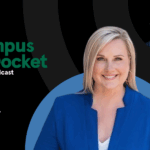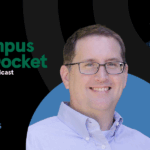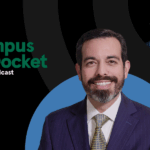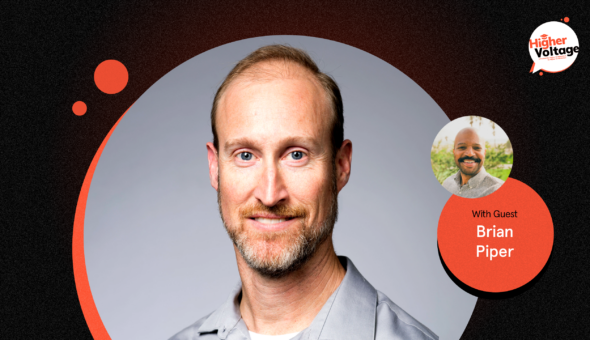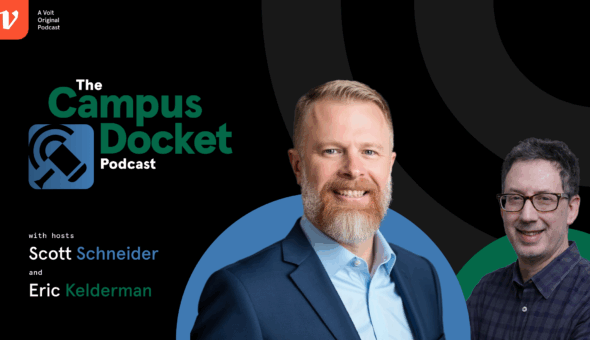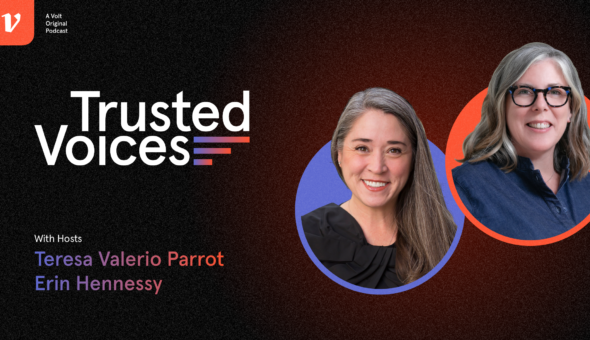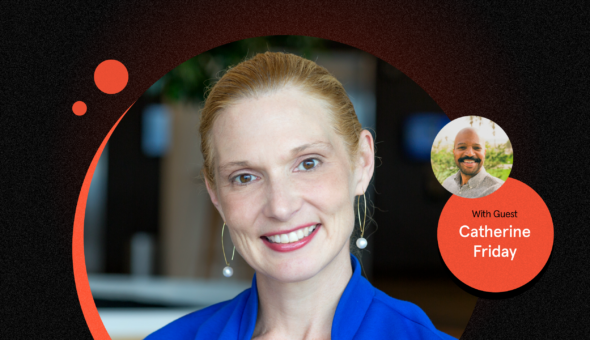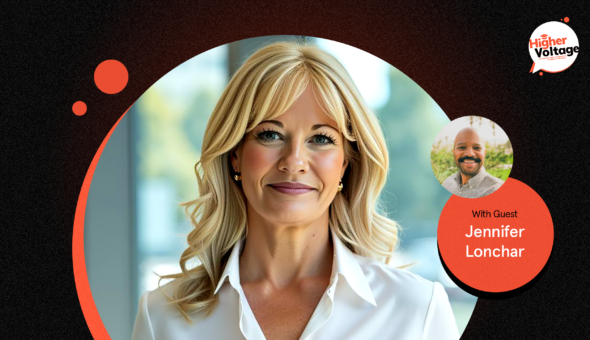Read the full transcript here
Teresa Valerio Parrot:
Hello and welcome to Trusted Voices podcast. I’m Teresa Valerio Parrot alongside Erin Hennessey. And in each episode, we discuss the latest news and biggest issues facing higher ed leaders through a communications lens. For these conversations, we’re normally joined by a guest who shares their own experiences and perspectives, but this season we’re also making time for one-on-one conversations about what we’re seeing, hearing and thinking.
So we do have some clips and some news items that we’ll be talking about later, but this morning we had a major record scratch to this program and that’s because this morning Inside Higher Ed released its annual president survey and we decided to pivot and focus most of our time talking about what the report said and what it didn’t say. So I am gonna share really quickly, I have this annotated copy here on Notability that is color coded and highlighted and we have notes.
Erin Hennessy:
Spectacular content for an audio medium, my friend.
Teresa Valerio Parrot:
I know, I’m really…right? I’m doing great. But it’s also on my screen in two different ways as well. So I have my notes ready. I am jazzed and I’m caffeinated. Erin?
Erin Hennessy:
You know, no one’s grading you on this, right?
Teresa Valerio Parrot:
Oh, this is for my own personal satisfaction.
Erin Hennessy:
This will not impact your GPA.
Teresa Valerio Parrot:
You know this is how I live life. If it can be done at a 12 on a 10 point scale, I’m all about that, so.
Erin Hennessy:
Okay, so here I know you want to dive in and roll around in the mud, but I just wanted to point out one thing, and I did a little digging around on the Inside Higher Ed website this morning. Can you, since you have it up on four different screens, can you read the headline of the story about this year’s survey?
Teresa Valerio Parrot:
Yes.Oh. Oh, so I don’t have the article up. I went straight to the report. I don’t need them to analyze it for me, ma’am. I’m kidding.
Erin Hennessy:
Well, I understand, but you’re undercutting my argument. Here it is: Annual President’s Survey Finds Optimism Amid Uncertainty. 2023’s headline: Hopeful Despite Headwinds. 2022 headline: College Presidents Confident in Finances, Upbeat About Race Relations. 2021 headline: Survey Shows College Presidents Emerging From COVID-19 More Confident Their Institutions Can Change and Thrive. Here’s what I’m going to say.
There’s a lot, there’s lots of good stuff in there. I don’t know that there’s a ton of surprising stuff in there, but you will tell me if I’m wrong. But man oh man, on some level it’s worth looking at this longitudinally to see if perspectives and mindsets are changing at all on our campuses and there’s some explanation, and I’ll cop to being a little more cynical than usual this morning, there’s some like explanation there for why things aren’t changing, why things are staying the way they are. Our challenges are still our challenges. We’re still worried about storytelling because I think in some ways our presidents are divorced from the reality through which we are all living.
Tell me I’m wrong.
Teresa Valerio Parrot:
I’m not going to. And you and I have talked about those headlines and the findings for years, because in my mind, when I fill out a survey, I’m honest because it is, it’s asking for your opinion. You’re supposed to be giving a snapshot of your institution. And I’m curious how many presidents are thinking about these surveys in that same way. If there ever was a quiet, dark place for you to have that conversation with yourself and some honesty about where your institution is and where it might be vulnerable, this survey is probably it.
But as we’re seeing, I think the honesty is coming in how they’re viewing their peers because across all categories, my institution is doing great financially and with race relations and with employee morale and pick a topic, but the industry is really sucking. And I think that what we’re actually seeing, I love that they have those two points because I think some of them are using the industry as the proxy for their own institution because they don’t have the fortitude, even in that dark, quiet moment with an anonymous survey, to be honest with themselves.
Erin Hennessy:
Yeah, and the, to give folks, president’s credit, Inside Higher Ed makes the point this morning in their, I think it was in their coverage, that there is some selection bias here, that folks who are in that deep, dark hole of despair and despondence probably aren’t going to fill the survey out at all. So there’s probably a skew there. But I think you’re right. And we say it all the time. Congress sucks. My congressman is okay. Higher Ed sucks. My institution is okay.
And so there’s a lot of like behavioral analysis I think that goes on behind there. I’d love to see some focus groups come out of this. As usual, if you’re listening, Inside Higher Ed, we’re going to have some recommendations and requests for you here. But that’s sort of where my head is at this morning being sleep deprived and cranky. But where is…what’s surprising to you in there? Is there anything that grabbed you?
Teresa Valerio Parrot:
So, yeah, I think there’s a baseline that I want to talk about for a second, because of course I’m going to go as nerdy as I possibly can. And that’s that, um, ha ha.
Erin Hennessy:
No one’s surprised. No one’s surprised.
Teresa Valerio Parrot:
And we’re going to talk about policies because that’s in here too. So of course, just looking at the methodology, I paused. Did you? Because this was an interesting little subset. So we’re talking about a president’s survey, and I just want us to be really careful because there were 380 respondents. Our sample size is 380 out of 4,000 plus. So I just want us to put that into context. And within this, 107 are public institutions that grant associate’s degrees.
So again, I think it’s great that we have associate degree granting institutions like community colleges and junior colleges that are participating, actually well below the percentage of how many community colleges we would have in the country, right? That over a quarter number is smaller than what we would see if we were looking at a representative sample. Having said that, I think that so many of us are jumping to also draw conclusions for four-year-plus institutions off of data that may not be able to support that. So I thought that was interesting. In here, there are 99 non-associate degree-granting public institutions. So again, just under or just over a quarter.
And then as we look at private institutions, then we’re looking at- we’re just split kind of well, we’re kind of split about half and half. So I just want us to make sure that we’re thinking about what those numbers look like in the actual report they also, in a couple of places, break down some of the findings based on gender and sexual orientation for a couple of those questions. So with that I just want to point out that for men and women, there’s 56% men 44% women. They also break down a couple of the statistics based on diversity and they’ll say, you know, it was over half of Black respondents. I just want to put those in context. So 380 people responded.
Erin Hennessy:
Fully or partially.
Teresa Valerio Parrot:
Fully or partially, correct. Yes. And who among us has not finished a survey? Um, so 380, 8% Black, 4% Hispanic. So if we have a third Hispanic, I just want us to be very careful about how many people we’re talking about. Um, because it’s a fun number to cite, but just thinking about that as a representational summary number is off.
Erin Hennessy:
Thank you, Professor.
Teresa Valerio Parrot:
You’re very welcome.
Electric Kite ad read
Teresa Valerio Parrot:
Oh, where do we even start? I think that there was this interesting conversation and thread throughout, again, about where I am versus where others are that touched on finances and also touched on have we thought about merging? And the two of those, I think are so intertwined. And even though they asked institutions as they looked at potential merger reasons why they were doing that, I think that a number of those can scaffold up to finances. So just thinking about those numbers and seeing that there is this dichotomy that we were discussing where one in six presidents say that senior administrators at their institution have had serious internal discussions within the last year about merging with another university. Among presidents already having serious merger conversations, two-thirds say their institution should consider merging within the next five years.
Erin Hennessy:
Yeah. And then overlay that with the ACE data we cite all the time about how many presidents are planning to step out of their position in the next five years. And I would say your responsibility is a president who might be eyeing the doors to do the hard things so your successor has set up for success, but I wonder how many of those presidents are going to push forward. I know it’s just the way that response is phrased, it’s as if the president has very little to do with moving the institution into a merger process. But it’ll be interesting to see if those presidents who are planning to step out of the role push those conversations ahead and do that hard work so that their successor can come in and move from a position of strength there.
Teresa Valerio Parrot:
Yes, and I do want to mention because they do, in the ways that they break down why you might want to merge, include positive reasons. So remember when you have a merger, you have the merger and the mergee. So they’re very different institutions. And I think that they’re, the ways in which they capture that data definitely allow for a merger to be a positive. And we’ve seen with some institutions that are actually looking at partners and they’re merging based on two institutions that have strength. So I always talk about this a little bit like Jack and Rose on Titanic, right? And there’s the door and there they are in the water and you’re thinking about a merger. And so you always have to question, am I Rose or am I Jack? And can this door support both of us? And this is a great reminder that sometimes there’s also a life raft next to you with the person blowing the whistle, sort of looking out there to see who else they might be able to save. So think about mergers not just as something that’s dire, but as something that can be a positive.
Erin Hennessy:
Yeah, yep. One of the data points that really grabbed me and per usual I’m like the, I’m doom and gloom and you’re a bit more positive I think, but the data and the responses around the intersection of politics and free speech on campus and presidents who feel…82% of respondents believe that the climate for open inquiry and dialogue on their campus is good or excellent.
Teresa Valerio Parrot:
Yes. Oh, I’m sorry that one…excuse me, I’m sorry keep going.
Erin Hennessy:
And secondly, an overwhelming majority of presidents, 93%, said their institution applies its speech policies fairly across all groups. I know this is an audio medium so listeners just imagine me staring portentously into the camera at this point. We are coming up on a political cycle that I think is, even if these numbers were accurate, is going to test these numbers in ways that a lot of people have not even begun to contemplate.
I think it’s very easy for campus leaders, presidents on down, I’m sure the student affairs colleagues on campuses are spending a lot of time thinking about what this fall is gonna look like, what protest activity is going to look like, what tabling by the college Democrats and college Republicans is going to look like. And I am guessing that, call it 82%, call it 93% of these institutions are not ready for what may come to their campuses this fall.
Teresa Valerio Parrot:
Erin, let me finish that section of the key findings because this part just, I have it highlighted in neon pink. And just about half of presidents, 54% disagree strongly or somewhat that current world events have stressed their institution’s speech policies to the point that they may need to be revisited. I would encourage 100% and by this, I strongly somewhat and very much encourage presidents to look at your speech policies to see if they apply to today’s world. All of you right now, look at those policies. Of all of the policies that we recommend that people do a periodic review of, this is at the top of our list.
Look at your speech policies because there are, so 54% think that they’re good. And I would say to that 46%, yes, I’m with you. Look at your policy. See what it says. And to the 54%, I say, you really need to look at your policy. Even if you looked at it last year. For all of the reasons that you just mentioned and for our New Year’s resolution episode, look at your speech policy.
Erin Hennessy:
Hmm. Yes. Also look at, and this is, you know, stepping away from survey results a bit, but look at your facility rental policies. Look at your policies around encouraging students to vote, whether at home or absentee. Look at all of the things that we do that touch on politics, because this cycle is going to be, I believe, more charged than any cycle we have ever, ever been through. Um, and I, I just can’t, even the institution in the best position right now today to navigate that has work to do. And I don’t have a counter up at the moment because, uh, it’s too early for that, but we’re about what? Six months out? Seven months out from November and things are going to get really bumpy this fall.
Teresa Valerio Parrot:
I just want to let everybody know that November 5th is Election Day and it’s also my birthday. So I’m just going to put that out there that please think good thoughts for me on my birthday. I was telling my husband I’m going to be celebrating or I’m going to be crying so there you go.
Erin Hennessy:
I hear a million-day planners cracking open as we speak.
Teresa Valerio Parrot:
Right? It’s my birthday, everybody. So I’m with you, I agree. And I think that there is, I recently worked with an institution to go through a list of what their policies are that tie in any way, shape or form to free speech or to allowing events on campus, anything that can be seen as a visual or a physical representation of free speech. And it’s a lot.
So think about, that’s everything from student affairs and how you approve flyers on campus to how you’re thinking about student groups and what they can put on social media if they’re a recognized and funded student group. The definition of what a funded and recognized student group is. All of these different pieces.
Erin Hennessy:
What your students are allowed to hang out their windows.
Teresa Valerio Parrot:
Yes, yes.
Erin Hennessy:
Sheets and banners and all of it’s just it’s everywhere, it touches everything.
Teresa Valerio Parrot:
It is everywhere. So go through those policies and maybe get a focus group of students, maybe of student government leaders and say, let’s walk through these guidelines and what do you think it says? I was just going through an ethics section of a student code of conduct yesterday.
And at the end of it, with all of the “whereas” and the “therefores” and the “not to exceed,” all of the phrases, I had no idea what they were allowing and what they weren’t from an ethical standpoint. Just be a good person. Would your mom be proud of you? And don’t cheat, right? That might be enough, but that’s not how we talk about these things. So do our students also have language that’s understandable for them and that they can apply to their own lives? That makes me think that 54% of presidents should rethink how they answered that question.
Erin Hennessy:
Yeah, yep.
Teresa Valerio Parrot:
Okay, what else stood out to you?
Erin Hennessy:
This is a topic that we talk about all the time. Again, going back to that ACE data where we are bracing for a huge turnover in the presidency in the coming three to five to seven years. The questions around what it’s like to do the job and the fact that 32% of respondents said they are more likely now than they were four years ago to discourage colleagues from taking the job.
We’re going to put aside the part where they say the greatest pressure is the financial constraints at 25%, even though so many people feel great about their finances at their institution. What…this is my plea to Inside Higher Ed and maybe Doug and Colleen can email me the cross tabs. But what I would love to see is that 32% broken out by gender and broken out by ethnicity. because I’ve got a theory that presidents of color and presidents who are women are feeling very differently about whether or not this is a good job than their white male peers.
Teresa Valerio Parrot:
Well, and I also think this is one of those places where I would like to see type of institution, whether it’s public, private, or it’s what types of degrees they provide because I think that we’re going to see some, I agree with you, we’re going to see them split among race and gender, and I also think we’re going to see a very different kind of response based on what type of institution.
Erin Hennessy:
Yeah, I also am, I’m fascinated by the pressures that sort of ended up at the top of the list. I really expected more personal stuff. Um, and, you know, to sort of the, the lack of sustainability and living this kind of lifestyle. I don’t know. I have been fascinated and have been reading every Saturday morning Rachel Toor’s, The Sandbox, which is put out by Inside Higher Ed. It is, if folks who are listening haven’t signed up for it, I strongly encourage you to do that. It is a place for presidents and only presidents to write anonymously about the challenges, the joys, and sort of what it’s like to do these jobs.
And there have been some really moving, really heartbreaking issues of the newsletter that have come out that are really focused on the personal cost of doing this job in the way that it is currently comprised and real personal challenges for women who are criticized about what they are wearing and what they look like, for presidents of color who are questioned about whether or not they deserve to be in these jobs, whether or not they are solely a token hire. Just some really ugly, ugly things that are happening on our campuses. And so I’m surprised that I don’t know what I would call it. I don’t think you can call the option “this job sucks,” but I’m surprised that sort of personal toll isn’t higher on this list.
Teresa Valerio Parrot:
Yeah, and this is one of those sections that I highlighted in neon pink as well, because I wrote a note to myself, what we see on our end is the emotional toll from all of these categories. And I think that they did have, you know, this is a lot of pressure, but I don’t think, and that didn’t score a very high percentage of presidents saying that was something that they’re working through, a challenge, it says, list of options of challenges. But I think what we’re seeing is it’s all of these things together that are creating that emotional toll.
So it doesn’t fit so easily into a category, it’s an all of the above. And that equals this emotional toll that they carry. And I wanna give a public shout-out to Raynard Kington, who had a piece in the Chronicle, where he talked about the fact that we don’t discuss presidential mental health enough. We don’t talk about anxiety attacks. We don’t talk about why it’s so hard for presidents to reach out and get sometimes help that they need with all that they’re dealing with. And I am just so pleased that he was willing to put that into words with his name associated with it. I think it’s great. I absolutely adore the Sandlot period. And I…
Erin Hennessy:
Sandbox.
Teresa Valerio Parrot:
Sandbox, Sandbox.
Erin Hennessy:
You’re killing me, Smalls.
Teresa Valerio Parrot:
There you go. Sandbox. It could be a Sandlot, there’s a movie. But I was really pleased, and I think there needs to be a space for those anonymous pieces, and I just could not have been more proud of him for putting his name around that too.
Erin Hennessy:
Yes. Ditto.
What else you got there?
Teresa Valerio Parrot:
I’m gonna go back to policies. Can we go back to policies for a second?
Erin Hennessy:
I suppose we can.
Teresa Valerio Parrot:
Okay, let me scroll all the way to the top. So there was a section on AI that I thought was interesting. But what I did think was interesting is that there were only 18% of respondents who said that they have AI policies including in teaching and research.
Erin Hennessy:
That surprised you?
Teresa Valerio Parrot:
It did!
Erin Hennessy:
In a good way or in a bad way? You were surprised there were those that few?
Teresa Valerio Parrot:
I’m not surprised there were that few, especially looking at the demographics and where the conversations have been held. But again, I think this is one of those places where we need to be thinking about what that looks like. And I do think that there’s this interesting take here because so often what we’re seeing with the AI policy conversation is how are you going to be thinking about and regulating and giving guidance on student behavior? But I do actually like that they include teaching and research as part of what they want AI policies to include. I think that is smart for institutions, and I also think it’s smart for scholars to be thinking about how they are generating their work and how they can talk about its development.
Erin Hennessy:
Yeah. Yeah, I was not surprised necessarily that that number was that small. That felt right-ish to me.
Teresa Valerio Parrot:
Yeah. I feel like there was so much conversation, at least around the need for these policies, last fall. So I think perhaps we had the conversation around the need for the policies, but maybe this is also a reflection of the fact that if you are talking about teaching and research, this would probably be in a faculty handbook and needs to go through shared governance as well. So this could be a reflection of how long that takes. It could also just be a reality check around the policy processes for institutions as well.
Erin Hennessy:
Yeah, and the speed at which they move.
Teresa Valerio Parrot:
Yes.
Erin Hennessy:
Hmm, hmm. Shared without comment.
Teresa Valerio Parrot:
Yes. What else were you thinking about with this?
Erin Hennessy:
Um, you know, those were, those were some of the big things that jumped out. Um, looking at the mental health data is always just…woof. Just, you know, sort of heartbreaking. Um, I thought that it was very interesting the way the question was phrased around non-clinical steps taken on campus. I really would have loved to see this broken out for students, for faculty and staff, instead of all of that lumped in together.
And I would have loved, you know, again, here’s my wish list for next year. I would have, to your earlier point, loved to have seen some questions about mental health for presidents. Whether or not they feel that the job is harder or easier, whether or not they feel that they are able to, in their community, you know, knowing that the president is often a small-town celebrity, do they feel able to access mental health supports? Who’s in their, not professional network, but in their personal network? Who are they talking to about the the challenges and the disappointments of the job, those kinds of questions specifically aimed at people in these positions, because I, to your point, and we’ve worked with a couple presidents who have talked about their mental health challenges, I think that’s a conversation that needs to happen. And I think for the benefit of our students and staff, presidents need to be having that conversation and talking frankly about their challenges and their needs in the sphere of mental health.
Teresa Valerio Parrot:
I agree with you and I don’t think this survey can produce the results that we would want for this reason: If presidents are saying everything is great on my campus with finances, yet my biggest stress is finances, if they are saying everybody else is having problems with finances, it’s not us, are they going to give that level of inflection in their response?
Erin Hennessy:
Yeah, everybody’s falling apart, but I am doing great.
Teresa Valerio Parrot:
So you would have to have a companion, what is your mental health versus what are your peers? So that you can have, no, I’m joking, but I really wish that was covered somewhere. And I think instead that’s why the Sandbox is so important because it provides that opportunity for sharing without having your name associated with it.
Erin Hennessy:
Yeah, I just, as we always talk about, I just love to see data. The anecdote is important and as we’ve said, having the conversation at any level, anonymously with a byline is great and important and I don’t poopoo that at all, but I really would love to see data.
Teresa Valerio Parrot:
Mm-hmm. Right. I’m going to go back to one last thought. And then if we want to just do a round-up of some clips that we’ve seen, that would be great. But I was curious about 83% of presidents who say their institution has taken at least one of a list of possible steps to educate students, faculty, and staff about the importance of free speech and to prepare them to engage with those whom they disagree.
So here’s the interesting part of that. If you actually look at the breakdown of the data, 26% of those institutions include some kind of discussion during orientation or first-year seminars. And so that means that as we’re talking and we’re hearing from families and we’re hearing from alumni and we’re hearing from a number of people who are saying, how are you supporting students in the conversations around Gaza in tough conversations?
Nearly three quarters of those conversations are not happening with students.
And if they’re happening at orientation and as part of a first-year seminar, are we making sure that we’re also talking with transfer students? Are we making sure that we are talking to students beyond just their first year when they’re drinking from a fire hose of all of what’s new at an institution? How are we going back and revisiting what it means to have a civil conversation and how to be a part of a community that asks tough questions?
Erin Hennessy:
And how do we make it real for them? To your point, is it just reading them the “whereases” and the “therefores” and the “hereafters” and whatever, or are we making this tangible, relevant, applicable to their everyday life, to their experience in the classroom, to their experience in the dining hall, to their experience walking by that banner or sheet hanging out of another student’s window. How are we preparing them for that?
Teresa Valerio Parrot:
Right? As much as we’re talking through what could this look like, we need to prepare them for what could they experience.
Okay, so the survey is on Inside Higher Ed. There are a whole bunch of other categories that we kind of touched on quickly, including how people are thinking about confidence in higher education. We aren’t gonna go through that because we’ve talked about that so many times, right?
Erin Hennessy:
Big sigh. I’m leaning away from the microphone for the big sigh. But we did include in the show notes, both the link to IHE story this morning, as well as the link to download the report if you want to dig into the data and annotate things like my good friend, Teresa Parrot.
Teresa Valerio Parrot:
Yes, yes. Anybody else a Notability fan who wants to compare all of their notes, let’s jump on a Zoom so we can share screens.
Erin Hennessy:
Goodness. And just a reminder that IHE usually offers, oh, it’s a webcast, which there’s information on the website to hear folks at the outlet talk about what they saw, what was interesting to them, comparisons over previous years, etc.
Teresa Valerio Parrot:
Exactly.
Erin Hennessy:
What else have you got?
Teresa Valerio Parrot:
I wanted to just mention a couple of links that I thought were really touching for me. One was, there is a piece that is in Open Campus and the headline is “After 27 Years in Prison a 54-Year Old is Now Getting His Ph.D.” I thought it was a fantastic piece that’s centered at the University of Iowa and talks about this student’s struggles. And it made me think about my doctoral program. We each, our first semester, were able to propose a student population that we would like to learn more about. And this is the student population I wanted to learn more about.
So I had my class do a reading that will be in the show notes, that is still, it’s a 2020 guidance from NASPA that I think is really interesting. It’s called Five Things Student Affairs Professionals Can Do to Support Justice-Involved College Students. And I think that some of what this doctoral student was talking about and experiencing, I think can also be addressed through some of these five things. And I also wanna give a shout-out, we had guest speakers in that course, Dr. Melissa Abeyta, and now Dr. Joe Luis Hernandez. And Joe was in, is a formerly incarcerated academic, and he talked about what his journey was like, and his story was so moving and so fascinating and was just inspiring. And I saw that he is going to be presenting at NASPA. They have a special interest group that is focused on justice-involved college students. And I hope that people go to his session because his story and the work that he does now and the scholarship that he and Dr. Abeyta do is just really, really important for higher education.
Erin Hennessy:
That’s great. I will put that on my schedule for the NASPA conference, which is in Seattle in just a week and a half, maybe 10 days. Very excited to be out there. And I will definitely add that to my list of sessions.
Teresa Valerio Parrot:
So Erin, tell us what session you think people should be going to at NASPA.
Erin Hennessy:
Well, I really do believe that if you are interested in student affairs, you have, over the past 30 years, benefited from the work of NASPA president Kevin Kruger, who is coming up on the end of his run at the organization. And I’m so excited to have the opportunity to spend some time with Kevin at the meeting, basically engaging in a conversation like this. And I’m not going to preview any of the questions because I don’t want Kevin to be able to prep in advance. I want to take him by surprise.
Teresa Valerio Parrot:
Have you written them yet?
Erin Hennessy:
No, of course not. No. By the time people hear this, maybe. If you have questions send them in. But I’m really excited to talk to him just about the changes that he’s seen in the profession over the course of his career. What’s keeping him up at night but also what is keeping him optimistic. And just to really let him talk about whatever he wants to talk about. So if you are going to be in Seattle and you get to the conference on Monday afternoon, our session I believe is at 3 o’clock local time, Monday afternoon, March the something, 11th, 12th, come spend some time. And if you want to go to the market and catch fish with me, I’m open to that as well.
Teresa Valerio Parrot:
And get some fantastic coffee and see some people.
Erin Hennessy:
Yes, that’s what I need. I need some coffee in my life.
Teresa Valerio Parrot:
Excellent. I wanted to also give a shout-out to the Albert Einstein College of Medicine. And I wanted to just congratulate them that they are now tuition-free based on a billion-dollar gift.
Erin Hennessy:
You are like a little ray of sunshine today. This is a lot of good news from you.
Teresa Valerio Parrot:
I…yes! I know, especially after we talk about a report that has ups and downs. I just thought that was such a fantastic way for us to be thinking about philanthropy. I loved the video. I’ve watched it a couple of times, of the announcement. I have done some deep dives on this institution and who goes there. And I think this was just exactly what my higher ed heart needed.
And I also think there is a policy brief that I want to mention to all of you. It was put out by CASE. It’s the Voluntary Support of Education brief. And it talks about how much money was raised in the last fiscal year for higher education. So the total was $58 billion. They have an overall summary. They’re gonna come out with some disaggregation of data later this year. But they talk about what that means for higher education. And at least in thinking about the last fiscal year, they put that within the context of how that represents trust. There’s $58 billion worth of trust that was put into higher education in that fiscal year. So I’ll be curious to see what next year’s data says and how that number may or may not be different from 58 million. But the other thing that they talk about is the fact that there’s an increasing number of 100 million plus gifts and that’s definitely a trend and a shift that we’re seeing. And it’s probably not too surprising where some of those gifts went, which means that the $1 billion for Albert Einstein College of Medicine really made my heart happy.
Erin Hennessy:
Yeah, and the Chronicle of Higher Ed, just to give love to all of our favorite trade publications, dropped their Trends report this week, and one of the trends that they are watching for future years is that sort of mega philanthropy, mega donors, and the impact that those folks have on the organizations and institutions to which they donate. So there’s a nice dovetail there on that front as well.
Teresa Valerio Parrot:
Yes. Anything else, Erin?
Erin Hennessy:
I will just cop to the fact that my to-do list this week prohibited me from spending a lot of time reading anything that wasn’t my to-do list this week. So I am happy to let you share these rays of sunshine and I’m glad we had the chance to talk about them today.
Teresa Valerio Parrot:
Agreed. As always, it’s fantastic to chat with you.
Erin Hennessy:
Oh, get out of town. Thanks.
Teresa Valerio Parrot:
Thank you.
